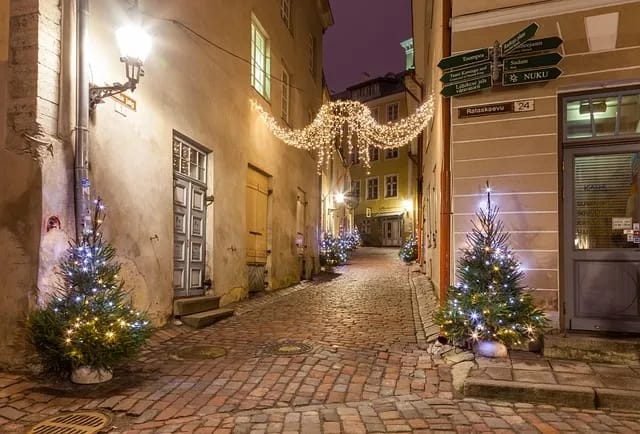When December rolls around and the air turns crisp, one of the most enchanting sights that signal the arrival of the festive season is the glow of Christmas lights. Whether they’re draped around trees, hung across rooftops, or twinkling in shop windows, these little points of light have a magical way of transforming ordinary spaces into winter wonderlands.
But have you ever wondered — what are Christmas lights actually called? Are they just “fairy lights,” or do they have more specific names? Why do we use them, and how did they become such an important part of Christmas traditions around the world?
Let’s dive into the fascinating world of Christmas lights — exploring their names, origins, varieties, and the cultural meanings behind their shimmering glow.
Read More:
- Christmas Lights In Different Cultures
- Permanent Christmas Lights: A Guide to Year-Round Holiday Cheer
- Christmas Lights Outdoor: Transform Your Home into a Winter Wonderland
1. The Many Names of Christmas Lights
Christmas lights go by several names depending on where you are in the world and what type you’re referring to. Though they all serve the same purpose — to brighten up the holiday season — the terminology varies across countries and contexts.
Here are some of the most common names:
1.1. Fairy Lights
In the United Kingdom, Australia, and New Zealand, Christmas lights are often referred to as “fairy lights.”
This term evokes a sense of magic and wonder — small, twinkling bulbs that resemble the sparkle of tiny fairies. The phrase “fairy lights” actually predates electric Christmas lights, originally referring to small candles used for decoration during festivals and theater performances.
1.2. String Lights
In the United States, the most common name is “string lights” or “Christmas string lights.”
This term refers to the physical design — a string or cord with multiple bulbs attached, often used to wrap around trees, staircases, or windows.
1.3. Twinkle Lights
Sometimes, you’ll hear people call them “twinkle lights.”
This usually refers to lights that blink or flash intermittently, mimicking the effect of stars twinkling in the sky. These are particularly popular for outdoor decorations and festive displays.
1.4. Festoon Lights
Another popular name, especially in design and event décor, is “festoon lights.”
Festoon lights are typically larger-bulb string lights with a warm glow, often used for both Christmas and year-round ambiance. They’re popular for patios, parties, and weddings — but during Christmas, they add a vintage or rustic charm to decorations.
1.5. Holiday Lights
In countries with diverse cultural backgrounds, like the U.S. and Canada, people often use the inclusive term “holiday lights” instead of “Christmas lights.”
This term embraces various celebrations that occur during the same season, including Hanukkah, Kwanzaa, and New Year’s festivities.
2. The Origins of Christmas Lights
Understanding what Christmas lights are called is one thing, but knowing where they came from makes their glow even more meaningful.
The history of Christmas lights is closely tied to ancient traditions, the invention of electricity, and even religious symbolism.
2.1. Candles and the Symbol of Light
Long before electricity, people celebrated the winter solstice — the darkest time of the year — with candles and fires to symbolize hope and the return of light.
When Christianity spread across Europe, candles became an important symbol during Christmas. The light represented Jesus Christ as the “Light of the World.”
By the 17th century, families began placing small candles on their Christmas trees — carefully attached with melted wax or pins. Though beautiful, this was an incredibly dangerous practice that often led to fires.
2.2. The Invention of Electric Christmas Lights
The transformation from candles to electric lights began with one man: Edward H. Johnson, a close friend and business partner of Thomas Edison.
In 1882, Johnson hand-wired 80 small red, white, and blue light bulbs and strung them around his Christmas tree in New York City. When he lit them up, it was a revolutionary moment — the first recorded use of electrically illuminated Christmas tree lights.
Newspapers initially mocked Johnson’s display as a novelty, but the idea caught on quickly. By the early 1900s, electric Christmas lights became available commercially, although they were expensive and mostly reserved for wealthy families or public displays.
2.3. The Rise of Affordable Christmas Lighting
By the 1920s and 1930s, thanks to companies like General Electric and NOMA Electric Company, electric Christmas lights became more affordable and accessible to ordinary families.
After World War II, colorful plastic bulbs and mass production brought Christmas lights into homes across America and Europe. Soon, lighting up one’s house became a symbol of festive spirit and community pride.
3. Types of Christmas Lights
Now that we know what they’re called and where they came from, let’s explore the different types of Christmas lights that people use today. The variety is enormous — from classic incandescent bulbs to modern LED and smart lighting systems.
3.1. Incandescent Lights
Traditional incandescent Christmas lights are the warm, glowing bulbs many people remember from childhood. They work by heating a small filament inside a glass bulb until it glows.
Pros:
- Warm, nostalgic glow
- Inexpensive initially
Cons:
- Use more electricity
- Generate heat
- Shorter lifespan
Despite their inefficiency, many people still prefer them for their cozy, vintage charm.
3.2. LED Christmas Lights
Modern Christmas lighting is dominated by LED (Light Emitting Diode) technology.
LEDs use significantly less energy, last much longer, and come in countless colors and effects.
Pros:
- Energy-efficient
- Long-lasting
- Cool to the touch
- Available in smart, color-changing versions
Cons:
- Slightly higher upfront cost
- Some prefer the warmer tone of incandescent bulbs
LEDs are often what people mean today when they talk about fairy lights or string lights.
3.3. Mini Lights
These are small, closely spaced bulbs on a thin wire — one of the most iconic Christmas light styles. They’re perfect for wrapping trees, garlands, or mantels.
3.4. C7 and C9 Bulbs
C7 and C9 are classic large-bulb lights often used for outdoor displays.
- C7 bulbs are smaller and used for trees or indoor décor.
- C9 bulbs are larger and brighter, ideal for rooftops and lawns.
Their rounded, colorful bulbs are a nostalgic favorite, giving off a retro holiday feel.
3.5. Icicle Lights
These lights hang down like icicles from gutters and roofs, mimicking dripping ice. They became especially popular in the 1990s and remain a staple of outdoor Christmas decorations.
3.6. Net Lights
Designed for convenience, net lights are a grid of interconnected bulbs you can easily drape over bushes, fences, or hedges — perfect for quick decorating.
3.7. Rope Lights
Encased in a flexible plastic tube, rope lights are ideal for outlining driveways, windows, or pathways. They create smooth, continuous lines of light.
3.8. Projection and Smart Lights
In recent years, projection lights and smart lighting systems have taken Christmas décor to the next level. You can now sync your lights to music, change colors with your phone, or even project animated snowflakes onto your house.
4. The Symbolism and Meaning of Christmas Lights
Christmas lights aren’t just decorative — they carry deep symbolic and emotional meanings.
4.1. Light as a Symbol of Hope
In nearly every culture, light represents hope, purity, and renewal. During Christmas — celebrated near the darkest days of winter — light reminds us that brightness always follows darkness.
4.2. A Religious Symbol
For Christians, Christmas lights symbolize the light of Jesus Christ shining in a dark world. The tradition of illuminating homes and trees honors that spiritual message of guidance and faith.
4.3. A Cultural Tradition of Joy
Even for non-religious people, Christmas lights stand for togetherness, warmth, and joy. They transform neighborhoods, spark nostalgia, and bring communities together in celebration.
4.4. The Psychological Effect of Light
Research shows that bright, colorful lights can boost mood and reduce stress. It’s no wonder people put them up earlier each year — the glow of Christmas lights genuinely makes people feel happier and more connected.
5. Global Christmas Light Traditions
Different countries have developed their own unique ways of using and naming Christmas lights.
5.1. United States
In America, decorating with string lights is almost a competitive sport. Entire neighborhoods light up with synchronized music displays, inflatables, and dazzling colors. Town squares and shopping centers also host “lighting ceremonies” that mark the start of the holiday season.
5.2. United Kingdom
In the U.K., people prefer the softer term “fairy lights.” Town centers like Oxford Street in London become famous for their elaborate light displays, often themed each year.
5.3. Germany
The birthplace of many Christmas traditions, Germany decorates its Christkindlmarkts (Christmas markets) with warm, golden lights. Germans tend to favor more traditional and understated designs, focusing on wooden stalls and candle-lit trees.
5.4. Japan
Though Christmas is not a religious holiday in Japan, illumination festivals have become a national attraction. Cities like Tokyo and Osaka host some of the most breathtaking displays in the world — with millions of LED lights arranged in intricate patterns.
5.5. Philippines
In the Philippines, the world’s longest Christmas season features parols — star-shaped lanterns symbolizing the Star of Bethlehem. Made from bamboo and paper, they are a local equivalent of Christmas lights and an important cultural symbol.
6. Eco-Friendly and Modern Trends
The world of Christmas lighting is constantly evolving, embracing new technologies and sustainability.
6.1. Solar-Powered Christmas Lights
As people become more eco-conscious, solar-powered lights are becoming popular. They absorb sunlight during the day and illuminate automatically at night, reducing electricity bills and environmental impact.
6.2. Smart Lights and Automation
With the rise of smart homes, many households use Wi-Fi-enabled lights that can be controlled through apps or voice assistants like Alexa or Google Home. You can change colors, set timers, or sync them with festive playlists.
6.3. DIY and Minimalist Lighting
Minimalist trends favor warm white fairy lights for a cozy, Scandinavian-inspired Christmas aesthetic. DIY enthusiasts use lights in jars, wreaths, and photo displays to create personalized décor.
7. Fun Facts About Christmas Lights
Here are some delightful facts about the glowing stars of the holiday season:
- The first outdoor electric Christmas light display appeared in 1927 in California.
- NASA astronauts have even decorated space stations with Christmas lights.
- The world’s largest Christmas light display (certified by Guinness World Records) featured over 3 million bulbs in Canberra, Australia.
- Some towns in the U.S. host “drive-through light festivals” that span several miles.
- Many cities recycle Christmas lights, turning them into copper and plastic for reuse.
8. Why We Love Christmas Lights
So, what makes Christmas lights so beloved?
It’s not just their sparkle — it’s what they represent. They remind us of warmth in the cold, hope in darkness, and connection in a busy world. When people gather to decorate their homes, it’s an act of joy and generosity. Each bulb we hang is a small symbol of love shared during the holiday season.
Conclusion: More Than Just Lights
So, what are Christmas lights called? Whether you know them as fairy lights, string lights, twinkle lights, or festoon lights, they all share one purpose — to illuminate our world with joy.
From their humble beginnings as candle flames to the energy-efficient LEDs that light up cities today, Christmas lights continue to evolve — yet their meaning remains timeless. They symbolize celebration, unity, and the unshakable belief that even in the darkest times, there will always be light.


